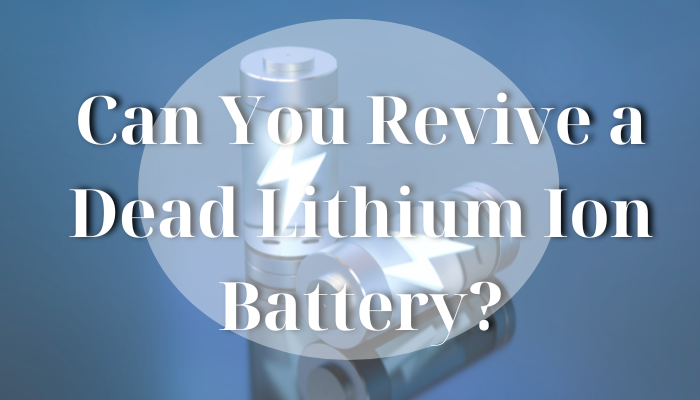Can You Revive a Dead Lithium Ion Battery?
Bring Your Battery Back to Life
“Can you revive a dead lithium-ion battery?” This is a question many gadget users and environmentally conscious individuals find themselves asking when faced with the disappointing sight of a battery that won’t charge. As we increasingly rely on lithium-ion batteries to power everything from smartphones to electric cars, understanding whether these power sources can be brought back to life after they’ve seemingly expired is more crucial than ever. In this article, we’ll explore the methods that might revive a dead lithium-ion battery, the safety precautions to consider, and when it’s better to recycle rather than attempt a revival.

Can You Revive a Dead Lithium Ion Battery? Don’t Panic: Not All Dead Batteries Are Truly Dead
Understanding Lithium-Ion Battery Discharge
Lithium-ion batteries are not immune to the phenomenon known as “deep discharge,” where batteries appear dead because they’ve been discharged below the voltage level at which typical chargers can recognize and recharge them. However, they often retain the potential to be revived. Deep discharge occurs when a battery is allowed to drain too low, often below 2.5 volts per cell. This can happen through extended periods of non-use where the battery naturally discharges or through heavy usage that drains it completely.
Signs Your Battery Might Be Revivable
- Voltage Check: If the battery’s voltage is significantly below normal but still above zero, there’s a chance it can be revived. A multimeter can help you measure this.
- No Swelling or Damage: Physically inspect the battery. If there are no signs of swelling, corrosion, or physical damage, the cells might still be intact, and revival could be possible.
- Response to a High-Quality Charger: Sometimes, using a high-quality charger that can activate at lower voltages might indicate the battery is still good if it starts taking a charge.
- Age and Usage History: If the battery hasn’t been in use for too long and hasn’t gone through many charge cycles, it might have a higher chance of revival.
Reviving a battery should be approached with caution, as attempting to charge a truly damaged or faulty battery can be dangerous. Always consider consulting with a professional or referring to specific manufacturer guidelines when dealing with seemingly dead lithium-ion batteries.
Can You Revive a Dead Lithium Ion Battery? Revival Techniques for Dead Lithium Ion Batteries
Safety First: What You Should Know
- Inspect the Battery: Check for any signs of damage such as swelling, leaks, or corrosion. If you notice any of these signs, do not attempt to revive the battery as it could be hazardous.
- Wear Protective Gear: Always wear safety glasses and gloves when handling batteries and using charging equipment to protect against potential sparks or corrosive battery acid.
- Use a Well-Ventilated Area: Ensure the area is well-ventilated to avoid the accumulation of potentially explosive gases released during the charging process.
- Have a Fire Extinguisher Nearby: Lithium-ion batteries can catch fire if improperly handled. Having a fire extinguisher specifically rated for electrical fires is advisable.
- Follow Manufacturer’s Guidelines: Always refer to the battery manufacturer’s guidelines for specific advice related to battery care and revival.
Safe Methods for Reviving a Dead Battery
Voltage Boosting:
-
- Step 1: Connect the dead battery to a healthy lithium-ion battery using wires. Ensure correct polarity by connecting positive to positive and negative to negative.
- Step 2: Allow the healthy battery to charge the dead battery for a few minutes. This can help increase the voltage level of the dead battery to a point where it can be recognized by a charger.
- Step 3: After a few minutes, disconnect the batteries and try charging the previously dead battery with its charger.
Using a Specialized Charger:
-
- Step 1: Obtain a charger that can charge batteries with very low voltage or a charger specifically designed for battery recovery.
- Step 2: Connect the dead battery to the charger, setting the charger to a low charging mode if available.
- Step 3: Monitor the charging process closely. If the battery accepts the charge and begins charging normally, continue until it reaches an adequate charge level.
- Step 4: Once charged, allow the battery to rest, then check if it holds the charge.
Jump-Starting with a Power Supply:
-
- Step 1: Set a DC power supply to the correct voltage (typically 3.7V per cell in series).
- Step 2: Connect the power supply’s positive and negative leads to the corresponding terminals of the battery.
- Step 3: Monitor the current and voltage carefully. If the battery starts to accept the charge, continue for a few minutes, then try charging with a regular charger.
These revival techniques should be used with caution and a solid understanding of the risks involved. Not all batteries are salvageable, and attempting to revive severely damaged or old batteries can be dangerous. Always prioritize safety and consult professional services when in doubt.
Can You Revive a Dead Lithium Ion Battery? Risks and Warnings
Potential Dangers of Reviving Batteries
- Fire and Explosion Risk: Lithium-ion batteries can catch fire or explode if damaged or improperly charged. This risk increases if the battery has been over-discharged or has physical damage.
- Chemical Leakage: Batteries that are compromised might leak hazardous chemicals, which are harmful to both human health and the environment.
- Electrical Short: Attempting to revive a battery with a short circuit can lead to further deterioration and potential danger.
- Ineffective Revival: Often, a battery that appears to be revived may not return to its original capacity and could fail unexpectedly.
Mitigation Strategies:
- Use Appropriate Tools: Always use chargers and cables that are specifically designed for lithium-ion batteries.
- Monitor Closely: Keep a close eye on the battery during the revival process. If the battery gets excessively hot, stop immediately.
- Professional Help: Consider professional assessment for batteries that are significantly discharged or have been inactive for a long period.
When to Give Up on a Dead Battery
- Zero Voltage: If the battery shows no signs of life and has a reading of zero volts, it’s often beyond saving.
- Swollen or Deformed Battery: Any swelling or deformation in the battery case is a clear sign that the battery is compromised and should not be used or attempted to revive.
- Age and Usage: Batteries that are several years old or have undergone hundreds of charge cycles are likely past their effective lifespan.
- No Response to Charging: If the battery does not respond to attempts at revival with specialized equipment, it likely cannot be restored.
In cases where revival is unfeasible or dangerous, proper recycling is the responsible choice. Recycling not only ensures safety but also helps in the recovery of valuable materials and prevents environmental contamination. Always turn to certified recycling centers that handle lithium-ion batteries.
Can You Revive a Dead Lithium Ion Battery? Maximizing Battery Health
Best Practices for Battery Maintenance
- Regular Charging: Instead of letting the battery drain completely, charge it frequently but avoid keeping it at 100% all the time. Aim to keep the charge level between 20% and 80% to minimize stress on the battery.
- Avoid Extreme Temperatures: Both high and low temperatures can harm battery performance and lifespan. Try to use and charge your battery in environments that are temperature-controlled or at room temperature.
- Use Appropriate Chargers: Always use the charger that comes with your device or one approved by the manufacturer. Using non-approved chargers can lead to poor charging practices and potentially damage the battery.
- Clean Contacts: Ensure the battery contacts are clean and free from debris to maintain good connectivity. This can be done gently with a clean, dry cloth.
Advanced Care Tips
- Battery Calibration: Occasionally allow the battery to discharge completely to around 5% before charging it back to 100%. This can be done every 2-3 months to help recalibrate the battery’s charge indicator.
- Software Updates: Keep your devices updated. Manufacturers often release software updates that optimize battery usage and health.
- Energy-Saving Settings: Utilize device settings that minimize battery strain, such as reducing screen brightness, turning off unnecessary apps, and using power-saving modes.
- Storage Conditions: If storing a battery or device for an extended period, keep the battery at a 50% charge in a cool, dry place.
Can You Revive a Dead Lithium Ion Battery? When It’s Time to Say Goodbye: Recycling Your Old Batteries
Environmental Impact of Lithium-Ion Batteries
Lithium-ion batteries, while highly efficient and widely used in various electronics, have a significant environmental impact. These batteries contain hazardous materials such as lithium, cobalt, and nickel, which can be harmful if not disposed of properly. When thrown in landfills, these chemicals can leach into the soil and water, posing risks to wildlife and human health. Additionally, the extraction and processing of these metals contribute to environmental degradation, including habitat destruction and water pollution. Proper recycling helps mitigate these impacts by recovering valuable materials and reducing the need for raw mineral mining.
H3: Safe and Responsible Battery Disposal Options
Proper disposal of lithium-ion batteries is crucial for environmental safety and efficiency in resource use. Here are some safe and responsible options:
- Local Recycling Programs: Many communities offer recycling programs that accept lithium-ion batteries. These programs ensure that batteries are processed in facilities equipped to handle their hazardous materials.
- Retail Drop-Offs: Some electronics retailers offer take-back programs where consumers can drop off old batteries for recycling at no cost. This service helps ensure that batteries are handled safely and in compliance with environmental regulations.
- Specialized Recycling Facilities: There are facilities specifically designed to recycle batteries, where they can safely extract valuable materials like lithium, cobalt, and copper for reuse in new batteries or other products.
- Manufacturer Take-Back Programs: Some manufacturers of electronic devices also run take-back schemes to encourage the recycling of old batteries from their products.
Conclusion
As we address the query, “Can you revive a dead lithium-ion battery?” it’s clear that while there are potential revival methods available, the risks often outweigh the benefits. Instead of risking further damage or unsafe outcomes, consider adopting proactive battery care strategies and consulting professionals when dealing with battery issues. Always remember, that recycling might be a more sustainable and safer choice when dealing with irreversibly damaged batteries.

Wow, this is a lifesaver! I thought my phone battery was toast, but thanks to your tips, I was able to bring it back to life. Huge thanks for sharing this knowledge!
This is such a valuable resource! I had no idea there were safe methods for reviving a dead battery. The explanation of lithium-ion discharge was very helpful too. I’ll definitely be recommending this article to my friends.
Fascinating read! I learned so much about how lithium-ion batteries work and how to extend their lifespan. The proper charging habits section is a game-changer – I can tell a difference already!